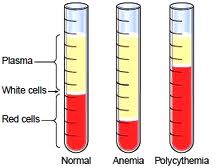It turns out that a randomized controlled trial was published early online this weekend in NEJM in which the authors concluded that a hematocrit goal of <45% was associated w/lower of risk of cardiovascular death or thrombotic events in patients avg 65yo w/polycythemia compared to a goal of 45-50%. In essence, 365 patients w/polycythemia vera were followed for an average of 31 months after randomization to either of the two stated goals. Normal reference range for hematocrit goes up to 51% or so depending upon the lab, so it's interesting to note that normal isn't necessarily optimal!
In an analogous situation, testosterone is known to stimulate bone marrow production leading to secondary polycythemia. This is usually due to supraphysiologic levels so I always recommend smaller more frequent doses for those who take injectable testosterone. But if the hematocrit still runs high despite my best attempts to smooth out the peak & trough, I then recommend therapeutic phlebotomy to minimize this same risk of cardiovascular death & thrombotic events. Granted this study was performed on a population of patients w/PV, but it does make me wonder about its generalizability to secondary polycythemia.
Tweet





No comments:
Post a Comment